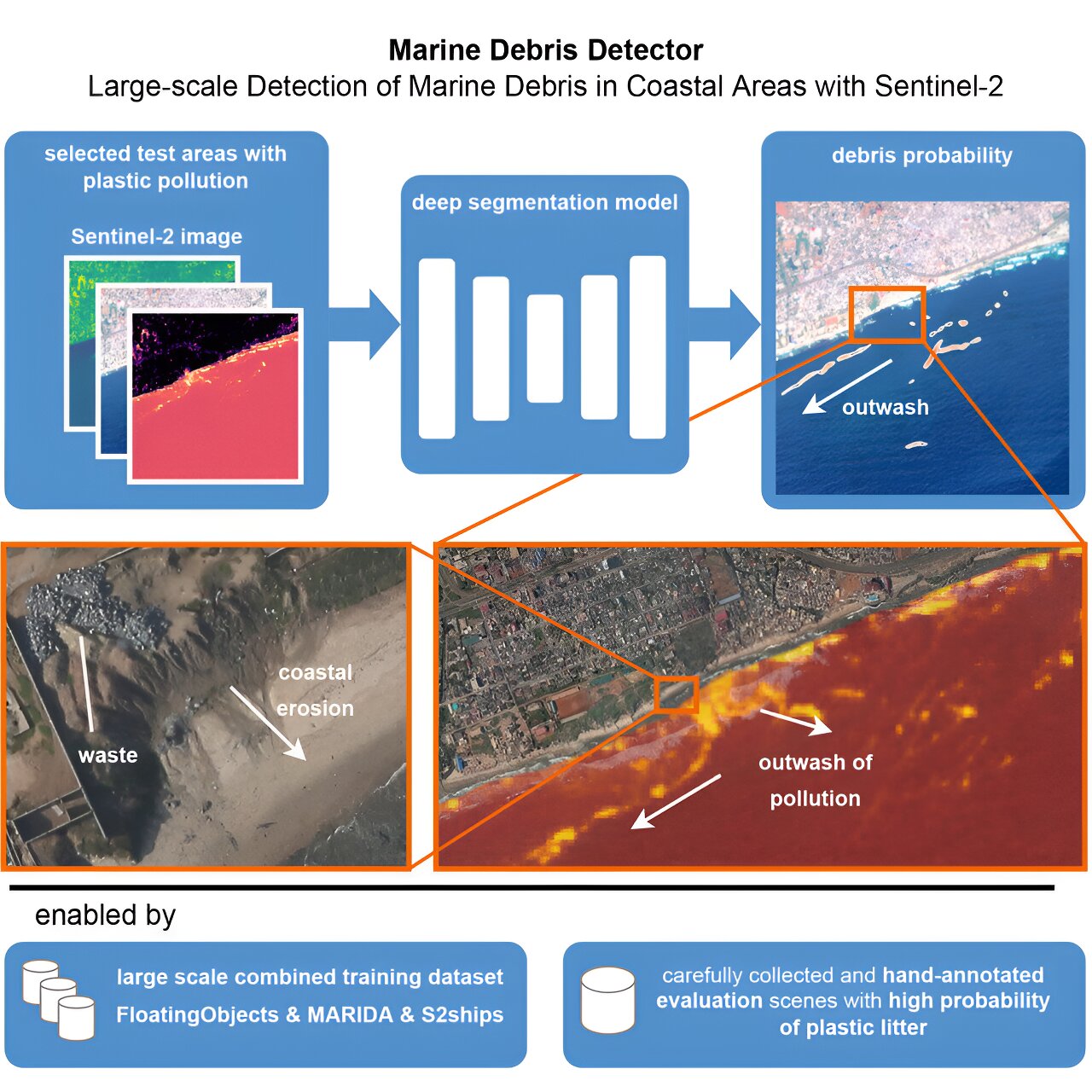Every night, an increasing volume of plastic waste finds its way into the ocean. Utilizing satellite imagery, researchers can locate and eliminate waste that has gathered along coastlines and at sea. Even in cases where satellite images are partially obscured by clouds or affected by windy conditions, a novel artificial intelligence system has been developed to identify floating polymers with greater precision than ever before.
Plastic items play a significant role in our society, and the accumulation of plastic waste is expected to escalate. Without proper disposal or recycling, a substantial amount of plastic waste accumulates in lakes and rivers before eventually making its way into the oceans, where it can amalgamate with natural materials like wood and algae to form clusters.
A recent study published in iScience by scientists from Wageningen University and EPFL introduces an AI-powered sensor that can assess the probability of coastal debris visibility in satellite imagery. This innovation, when deployed on boats, could facilitate the systematic removal of plastic waste from the ocean.
Leveraging AI for Analyzing Satellite Images
Sentinel-2 satellite images covering southern regions every 2–5 days worldwide capture accumulations of marine debris on land masses and coastal areas. Given the massive volume of data involved, artificial intelligence techniques like deep neural networks are essential for swift data analysis.
These models are trained using examples provided by oceanographers and remote sensing experts who have visually identified numerous instances of marine litter in satellite images across various global locations, as explained by Marc Rußwurm, an associate professor at Wageningen University. By “training” the model in this manner, it learns to detect marine debris effectively.
Enhanced Monitoring in Challenging Conditions
To predict the presence of marine debris in each pixel of Sentinel-2 satellite images, researchers have developed an AI-driven marine debris detector. This sensor is trained using data-centric AI methodologies that aim to maximize the utility of limited training data available for addressing this issue.
One notable development is the formulation of a computer vision algorithm that precisely correlates with expert manual annotations of debris in images. This tool allows oceanographers and remote sensing professionals to provide additional training data examples, thereby enhancing the model’s accuracy in identifying marine litter.
Thanks to this training approach and refinement algorithm, the deep artificial intelligence detection model excels at identifying marine debris objects more effectively than previous methods, even under challenging conditions such as cloud cover and atmospheric haze.
The sensor maintains accuracy even in adverse scenarios, where existing models struggle to pinpoint marine debris accurately, according to Rußwurm.
 Sentinel-2 image featuring expert annotations of marine debris, illustrating trash discharge into the Indian Ocean. Image credit: ESA
Sentinel-2 image featuring expert annotations of marine debris, illustrating trash discharge into the Indian Ocean. Image credit: ESA Plastic waste accumulation in Durban Harbour. Credit goes to Ash Erasmus.
Plastic waste accumulation in Durban Harbour. Credit goes to Ash Erasmus.
Tracking Marine Debris Post-2019 Easter Floods in Durban
Given that plastics are often washed into open waters following rainfall and flooding events, it is crucial to detect them amidst aquatic debris under adverse weather conditions involving clouds and haze. The 2019 Easter storms in Durban, South Africa, exemplify this scenario: Prolonged rainfall led to river overflows, resulting in a higher-than-usual volume of waste being carried away.
This waste was transported into the Indian Ocean via the Durban port. Traditional color schemes like red, green, and blue make it challenging to identify objects floating amidst clouds in satellite images. However, switching to alternative spectral bands, such as near-infrared, enables better visibility.
The Dual Monitoring Approach for Enhanced Insights
In addition to improving the accuracy of coastal debris predictions, the diagnostic model can identify debris in PlanetScope images, which are available daily.
Rußwurm highlights that “Integrating routine Sentinel-2 observations with monthly PlanetScope acquisitions can bridge the gap towards continuous daily surveillance.”
Furthermore, the simultaneous capture of the same marine debris area by Sentinel-2 and PlanetScope, albeit minutes apart, reveals the effects of wind and ocean currents on water movement. This dual monitoring approach can enhance models for estimating marine debris drift patterns.






